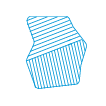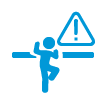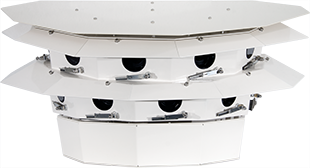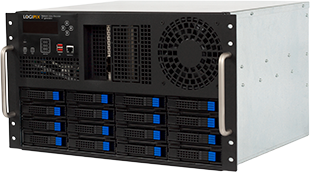The new decade showed that civil aviation must start a new era and airports must adapt to new directives. They have to prepare for increased travel demands and unforeseen events while maintaining a high level of safety, even with reduced human resources. In addition to these new challenges, old ones persist. Delays caused by inefficient ground operations have always been a firm issue, as even a brief delay can trigger a snowball effect. Extending the size of airports, or multiplying assets is not feasible in most scenarios to address this problem. The key lies in expansive progression, where not the size, but the applied technology brings the desired effect.
To maintain sustainable growth and increase overall throughput while protecting people and assets, airports must utilize smart operations and gain more efficient control over the airside. LAARS was specially developed with this in mind. The solution brings extended vision and AI-powered analytics into airside monitoring. It provides enhanced, guided focus on ground operations, resulting in improved efficiency, reduced delays, and prevention of minor and major incidents. Additionally, it offers comprehensive object-based historical search and data collection, facilitating decision-making in safety and efficiency issues, and accelerating investigation processes.
LAARS makes the airside more visible for operators, and it also helps better understand what is happening in the monitored area.
■ It provides contiguous, high-resolution coverage on the entire airside with only a few 300-960 MP Panorama Cameras.
■ It uses AI-powered Computer Vision to analyze and register all objects and their movements, whether they are cooperative or non-cooperative.
■ With custom Real-Time Decision Making Support it helps prioritize situations and guide the focus of operators to the most urgent ones.
■ It creates organized datasets based on registered object movements, which are beneficial for KPI calculations and it also assigns visual content to all these records.
■ Its advanced object-based historical search accelerates finding certain situations within everyday operations and also expedites formal investigations.

Thanks to the Object Tracking function, the system is aware of object locations within the monitored area. Object Classification specifies the object types. Geofencing allows the virtual mapping of airside zones onto camera images, enabling the assignment of actual airside rules to these zones.
These low-level algorithms enable high-level functions, such as different designated path monitoring and violation detection functions and virtual access control. Operators receive alerts in various proximity or possible collision situations and the system also sends FOD warnings.
They can use versatile filters to find specific cooperative or non-cooperative objects on the airside and utilize automatic tracking functions for effortless monitoring.
The RTDMS optimizes the front end visualization of all signals generated in the system, as it highlights only the most relevant or urgent situations. This function makes it possible to efficiently handle the large number of situations arise.
LAARS captures the very moment of landings and take-offs and registers the exact time that airplanes spend on the airside. Therefore, it makes billing procedures fast, easy and accurate. It also captures all violations and creates a detailed violation list automatically, making it easy to browse within and generate reports on demand.
By transforming the visual content into informational datasets, LAARS plays a crucial role in optimizing ground processes and identifying operational bottlenecks. Therefore, it ensures smoother and more secure airside operations.
These arranged datasets serve as the solid base for analyzing airside ground movements. Utilizing this information, mid and long-term decisions can be made in order to make the airside safer and more efficient.
As all movements and status changes are registered of the automatically tracked objects, LAARS allows to search for these records, realizing comprehensive object-based search methods. This function accelerates the process of finding visual evidence of certain situations, and facilitates investigation processes.
Financial Benefits
■ Minimizing installation costs – Since only a few panorama cameras are required to cover even the largest airside, it is possible to reduce both the camera mounting and network infrastructure expenses.
■ Effortless maintenance – The hardware of the system consists of only a few devices, moreover the panorama cameras are equipped with automatic self-cleaning and deicing systems.
■ Less human resources – Fewer personnel is needed to manage the airside while maintaining an even higher safety level.
■ Decreasing delays, increasing airside throughput – The system provides accurate data, both visual and non-visual, for measuring ground process efficiency, facilitating effective mid-term and long-term strategic decision-making.
■ Avoiding financial loss by preventing accidents – LAARS provides computer vision technologies to prevent various incidents, which helps avoid significant.

Intelligent functions are able to ensure safety of air crews, employees and passengers on the airfield and facilitate airside contol tasks on the ground.
Operational Benefits
■ Contiguous high-resolution coverage – A few Panorama cameras can cover the entire airside in high resolution. They function as a unified sensor system. Therefore, LAARS is able to manage object tracking throughout the entire airside without losing the detected objects when they move from one camera image to the neighboring one.
■ Increased situational awareness – LAARS helps operators to make informed decisions, respond emergencies, and coordinate activities effectively. Utilizing the system’s functions they are aware of the location and movement of aircraft, vehicles and personnel and any potential hazards or security threats.
■ Enhanced operational efficiency – Using the LAARS, operators are able to manage ground processes at a higher, AI-powered level.
■ Real-time Decision Making Support – LAARS always highlights the most relevant situations on screen using Augmented Reality. Smart display functions guide the focus of operators. The entire front-end interface is designed to facilitate airside monitoring.
■ Applicable airside rules – LAARS enables to virtually configure airside rules within the system. Automatic traffic enforcement and access control functions are based on this set of rules.

LAARS automatically tracks both cooperative and non-cooperative objects within the monitored area. This ensure that operators are always aware of objects’ real-time and historical location and they can lock automatic tracking on selected objects.
The system classifies various objects with high precision. Operators can utilize this function to filter for airplanes, vehicles, personnel, and the system can also generate alerts for unauthorized entry, FOD and animal presence in the airside area.

This low-level function allows to divide the airside area based on the physical layout and virtually assign airside rules to these areas with different conditions.

LAARS provides real-time, 2-level runway incursion detection with less then 1 second latency. It detects and alerts regarding airplanes, ground vehicles, personnel, and even animals, whose unauthorized presence nearby or on the runway poses a potential source of incidents.

The function allows air traffic controllers to have an enhanced visual representation of the aircraft’s approach and provides AI-based information to support their decision-making process.

LAARS automatically registers the very moment of all airplane landings and take-offs, and saves evidence images. In case the LAARS receives transponder information, it can automatically calculate the exact time that the airplanes spend on the airport.


Virtual fence function makes it possible to assign different airside rules to temporarily designated areas.

LAARS is able to automatically detect several types of traffic violations throughout the airside. Several rules can be configured for both cooperative and non-cooperative objects.

LAARS helps prevent critical incidents on the airside. The system analyses the motion of moving objects and alerts operators in time to assist pilots and drivers to avoid collisions.

The function defines and projects proximity areas around tracked objects. The size of the proximity areas dynamically varies based on the object’s type, status, speed, and airside zone.


Automatic FOD detection function helps avoid serious incidents at the airside. The size of the smallest detectable FOD depends only on the applied resolution.

The system can provide advanced perimeter protection functions, either using AI-powered computer vision or operating in cohesion with an integrated PIDS.

Instead of the simple time-based archive search, LAARS offers a sophisticated object-based search module. This module allows for searching specific incidents, designated area movements and also for particular objects.




LAARS allows for the utilization of data originating from the AIDB. The AIDB serves as a comprehensive repository providing information on runway parameters, taxiways, airplane stands, navigational aids and airport services. Integrating these diverse sets of data within LAARS enables a more holistic view and analysis of airport operations.
ADS-B transmits real-time aircraft data, including identity and GPS-based position. This data can be utilized in LAARS for more precise positioning on the interactive map and it can be also visualized on the informational object labels.
MLAT helps tracking aircraft that might not be equipped with ADS-B or radar transponders, improving overall surveillance coverage and accuracy. Integrating MLAT data within LAARS enhances the situational awareness for air traffic controllers and airport operators.
Integrating A-SMGCS data within LAARS allows for a more comprehensive understanding of ground movements. This integration aids in preventing collisions, reducing runway incursions, optimizing ground traffic flow, and enhancing safety protocols for aircraft and vehicle operations on the airport surface.
The Logipix Virtual PTZ module makes it possible to display both the video streams and high-level LAARS functions within a third-party VMS. To transmit both video and AR visualization elements, LAARS fuses this information and generates a standard, transferable ONVIF stream.
LAARS is the purpose-designed software that makes it easy to use the functions of the Logipix Airside Augmented Reality Solution. This video guides you through its functional capabilities that are available for the user.
Logipix Ltd. enhanced the vision of ground controllers at the airside of LaGuardia International Airport by deploying its high-end video monitoring solution, the LAARS. The core sensors of the system are the Logipix 300 MP Panorama Cameras. LAARS operates as a virtual tower at the LaGuardia Airport, allowing ground controllers to observe so far obscured apron areas with unmatched image quality and resolution.
Logipix Ltd. enhanced the vision of ground controllers at the airside of Mumbai International Airport by deploying its high-end video monitoring solution, the LAARS. The core sensors of the system are the Logipix 300 MP Panorama Cameras. LAARS operates as a virtual tower at the LaGuardia Airport, allowing ground controllers to observe so far obscured apron areas with unmatched image quality and resolution.
LAARS is the purpose-designed software that makes it easy to use the functions of the Logipix Airside Augmented Reality Solution. This video guides you through its functional capabilities that are available for the user.
The Logipix 200 MP Panorama Camera provides full coverage of the airside and delivers stunning images even in bad weather conditions.
LAARS is the purpose-designed software that makes it easy to use the functions of the Logipix Airside Augmented Reality Solution. This video guides you through its functional capabilities that are available for the user.
Thanks to our high resolution panorama camera we are able to see tail numbers even hundreds of meters away.
Let’s see how Logipix Airside Video Monitoring Solution makes ground control easier and more effective using advanced VCA technology.
FOD feature in LAARS registers the source of the FOD, which can be reviewed instantly on the user interface. The hi-resolution footage provides an irrefutable evidence.
FOD feature in LAARS provides constant automatic search for foreign objects within the monitored area, and it also guides an instant investigation for finding the source of the FOD.
Download our Brochure about the Logipix Airside Augmented Reality Solution. Be familiar with this system, which includes high-end hardware components and cutting-edge software, delivering AI-powered functions for intelligent monitoring.

Read more

Download our Brochure about the Logipix Advanced Ramp Control Solution. Be familiar with this system, which includes high-end hardware components and cutting-edge software, delivering AI-powered functions for intelligent monitoring.
Read more


With only 5 minutes of reading, you will have have a brief insight into our high-end airside monitoring solution. Be prepared to equip your airport with future-proof technology.
Read more


With only 5 minutes of reading, you will have have a brief insight into our high-end airside monitoring solution. Be prepared to equip your airport with future-proof technology.
Read more



The Logipix Panorama camera produces hundreds of megapixel images with details that provides effective visual information in all lighting conditions.
The camera delivers wide dynamic range, has improved low-light performance and extra high sensitivity.
The Logipix 320 MP Panorama camera camera provides wide dynamic range images, have an improved low-light performance and extra high sensitivity.
The camera house is completed with an automatic self-cleaning system that consists of a tank with cleaning liquid, a dispenser system and wipers at every window for the best images.

The Logipix 300 MP Panorama camera camera provides wide dynamic range images, have an improved low-light performance and extra high sensitivity.
The camera house is completed with an automatic self-cleaning system that consists of a tank with cleaning liquid, a dispenser system and wipers at every window for the best images.

The Logipix 200 Mp Panorama camera images ensure an expanded view. Operators can continuously observe the whole monitored area on one camera image without redundant or hidden areas. The huge resolution even makes it possible to recognize faces at a large distance. The camera house is completed with an automatic self-cleaning system that consists of a tank with cleaning liquid, a dispenser system and wipers at every window for the best images.

The Logipix 960 MP Panorama camera images ensure an expanded view. Operators can continuously observe the whole monitored area on one camera image without redundant or hidden areas.
The huge resolution even makes it possible to recognize faces at a large distance.

This military grade camera provides expanded vision for unmanned aircraft systems. Equipping the drone with a 120 MP Drone Panorama Camera provides continuous 120° monitoring over the surroundings.
The rugged camera housing contains a 120 MP multi-sensor panorama camera for high-resolution visible light imaging.

The Logipix ONE 20 MP camera produces a 20 FPS video stream at full resolution, therefore any motion in the footage seems continuous. The device uses the visually lossless JPEG2000 wavelet-based compression method, compressing each frame separately. The video stream does not contain predicted frames.

The 20 Megapixel Day/Night Camera is encased in a rugged IP66 housing, designed to withstand vibration in accordance with MIL STD 810G. It provides high-performance images, even in extreme environmental conditions, in temperatures ranging from -40°C to +70°C.

The PTZ has a unique integrated Laser illuminator with an automatic cooperating focus system, it is able to provide quality images of monitored targets even in low lighting conditions.

The Logipix 2 MP PTZ ensures a high resolution and a 25 FPS speed. The camera provides effective manual target tracking thanks to its fast positioning and high accuracy within a 360° horizontal and 180° vertical range.
The PTZ has a unique integrated IR Laser illuminator with an automatic cooperating focus system.

Logipix NVR Rack-mount is a 4th generation, high performance network video recorder specially designed for the Logipix Panorama and single cameras.
7 Gbit/sec recording speed ensures the reliable recording of the 20 FPS video streams of the Logipix ONE cameras without any reduction in camera performance.

The Logipix NVR Outdoor is the high speed network video recorder of the Logipix solutions that was specially developed for on-site recording tasks.
The thermal control of the electronic components relies on a combined system of integrated heat pipes and fans, a thermoelectric peltier cooler and sunshields.

The Logipix Panorama camera produces hundreds of megapixel images with details that provides effective visual information in all lighting conditions.
The camera delivers wide dynamic range, has improved low-light performance and extra high sensitivity.

The Logipix 300 MP Panorama camera produces hundreds of megapixel large images on which every detail is clearly visible in all lighting conditions.
The camera provides wide dynamic range images, have an improved low-light performance and extra high sensitivity. This camera is able to cover large areas with high resolution from a single viewpoint.

The Logipix 320 MP Panorama camera camera provides wide dynamic range images, have an improved low-light performance and extra high sensitivity.
The camera house is completed with an automatic self-cleaning system that consists of a tank with cleaning liquid, a dispenser system and wipers at every window for the best images.

The Logipix 200 MP Panorama camera images ensure an expanded view. Operators can continuously observe the whole monitored area on one camera image without redundant or hidden areas. The huge resolution even makes it possible to recognize faces at a large distance.
The camera house is completed with an automatic self-cleaning system that consists of a tank with cleaning liquid, a dispenser system and wipers at every window for the best images.

The Logipix 978 MP Thermal & Visible light Panorama camera images ensure an expanded view. Operators can continuously observe the whole monitored area on one camera image without redundant or hidden areas. The huge resolution even makes it possible to recognize faces at a large distance.

This military grade camera provides expanded vision for unmanned aircraft systems. Equipping the drone with a 120 MP Drone Panorama Camera provides continuous 120° monitoring over the surroundings.
The rugged camera housing contains a 120 MP multi-sensor panorama camera for high-resolution visible light imaging.

The Logipix ONE 20 MP camera produces a 20 FPS video stream at full resolution, therefore any motion in the footage seems continuous.
The device uses the visually lossless JPEG2000 wavelet-based compression method, compressing each frame separately. The video stream does not contain predicted frames.

The 20 Megapixel Day/Night Camera is encased in a rugged IP66 housing, designed to withstand vibration in accordance with MIL STD 810G.
It provides high-performance images, even in extreme environmental conditions, in temperatures ranging from -40°C to +70°C.

The PTZ has a unique integrated Laser illuminator with an automatic cooperating focus system, it is able to provide quality images of monitored targets even in low lighting conditions.
Specially developed PTZ control functions in the Logipix Control Center, such as mouse controlled joystick emulation, the PointIT control function or PTZ position bookmarks make monitoring convenient and easy.

The Logipix 2 MP PTZ ensures a high resolution and a 25 FPS speed. The camera provides effective manual target tracking thanks to its fast positioning and high accuracy within a 360° horizontal and 180° vertical range.
The PTZ has a unique integrated IR Laser illuminator with an automatic cooperating focus system.


Logipix NVR Rack-mount is a 4th generation, high performance network video recorder specially designed for the Logipix Panorama and single cameras.
7 Gbit/sec recording speed ensures the reliable recording of the 20 FPS video streams of the Logipix ONE cameras without any reduction in camera performance.
The Logipix NVR Outdoor is the high speed network video recorder of the Logipix solutions that was specially developed for on-site recording tasks. Thanks to its massive outdoor enclosure with an IP65 rating, it is able to cope with even extreme weather conditions.
The thermal control of the electronic components relies on a combined system of integrated heat pipes and fans, a thermoelectric peltier cooler and sunshields.
